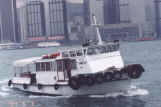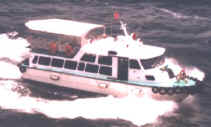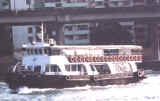 

The Development
of Motorboat Services in Hong Kong
|
 In
Hong Kong, the general public generally label small vessel
powered by engine as motorboat. Apart from carrying passengers,
some of the motorboats are deployed for towing purposes.
From 80s onward a finer definition on the vessels has
been made. Motorboats are referred to passenger - carrying
launches and the tugboats are confined to vessels with
towing purposes. The development of tugboats is separately
described in another article. In
Hong Kong, the general public generally label small vessel
powered by engine as motorboat. Apart from carrying passengers,
some of the motorboats are deployed for towing purposes.
From 80s onward a finer definition on the vessels has
been made. Motorboats are referred to passenger - carrying
launches and the tugboats are confined to vessels with
towing purposes. The development of tugboats is separately
described in another article.
In the early days of the Victoria Harbour, small boats plied
between two sides of the harbour and the ocean going vessels.
Landing points concentrated in the busy districts - Central,
Sheung Wan and Wanchai in the Island and Tsimshatsui, Yaumatei
and Tai Kok Tsui in the Kowloon Peninsula.
In 1898, Star Ferry was established and the Company was awarded
monopoly to run ferry services from Central to Tsimshatsui.
Other local Chinese motorboat owners formed motorboat companies
to strengthen competitiveness, such as the Republic Motor Boat
Co Ltd (1914) and the Moonraker Motorboat Co Ltd (1920). In
1924, the Yau Ma Tei Ferry Co Ltd was set up and was given
monopoly to operate other ferry lines. The significance of
motorboats in the cross-harbour ferry service has since then
been reduced to a supplementary role and after the completion
of the Hung Hom Cross-Harbour Tunnel in 1972, this role was
totally replaced.
 Walla-walla
was at first nick-named by the European passengers as the engine
of the vessel was very noisy. The outlook of the walla-walla
(Class 1 motorboat) did not change much in the past decades.
The wooden hull, the below-loadline cabin (ie without deck)
and the engine in the front part of the cabin were characteristics
of these boats. Gardner was the prevailent type of engine.
With the horse power under 100 HP, the speed was around 4-6
knots. Class 1 motorboat was allowed to ply in the sheltered
part of the harbour ie. Class 1 districts as defined by the
Marine Department. Walla-walla
was at first nick-named by the European passengers as the engine
of the vessel was very noisy. The outlook of the walla-walla
(Class 1 motorboat) did not change much in the past decades.
The wooden hull, the below-loadline cabin (ie without deck)
and the engine in the front part of the cabin were characteristics
of these boats. Gardner was the prevailent type of engine.
With the horse power under 100 HP, the speed was around 4-6
knots. Class 1 motorboat was allowed to ply in the sheltered
part of the harbour ie. Class 1 districts as defined by the
Marine Department.
 During
the Second World War, many walla-wallas were mobilised by the
Government for public service and were destroyed. After the
war, only a few were salvaged and repaired. Many new boats
were built. During
the Second World War, many walla-wallas were mobilised by the
Government for public service and were destroyed. After the
war, only a few were salvaged and repaired. Many new boats
were built.
From 50s to 70s, the means of communication in the harbour
was not well developed. The summon of motorboats by ocean going
vessels, except by prior arrangement of the ship's agents,
was mainly signalled by the hoisting of a special flag - the
so-called walla-flag. Motorboat kiosks were set up in the waterfronts
for the deployment of the boats. From 70s onwards, VHF was
deployed and in 90s, mobile telephone was introduced. Operation
of motorboats hence became much easier.
 The
50s and the 60s were the golden ages of motorboat business.
In the daytime, service to seafarers was the major business.
The cargo ships were breakbulk cargo carriers and the ships
stayed in port from a few days to a few weeks. The ferry services
to these ships were much frequent. The time after mid-night
was another rush hours for motorboats, especially during the
period from 1:30 am to 6:30 am when the regular cross-harbour
ferry stopped services. The
50s and the 60s were the golden ages of motorboat business.
In the daytime, service to seafarers was the major business.
The cargo ships were breakbulk cargo carriers and the ships
stayed in port from a few days to a few weeks. The ferry services
to these ships were much frequent. The time after mid-night
was another rush hours for motorboats, especially during the
period from 1:30 am to 6:30 am when the regular cross-harbour
ferry stopped services.
There were 3 distinct groups of passengers in need of motorboat
service during 3 busy sessions in late nights at Blake Pier,
Queen's Pier, Kowloon Public Pier and Jordan Road Landing Step.
The first group is the night goers. After the cross-harbour
ferry stopped service at 1.30 am, they can charter the whole
boat or buying tickets for the motorboat service. The rates
were regulated by the Government.
The second group is the transport workers of newspaper. From
4-5 am, they almost chartered all the motorboats for delivering
newspaper from Hong Kong side to Kowloon. Before 70s, all the
newspapers' offices and printing workshops were in the Island.
Newspapers were printed and ready by 4 am. Trucks delivered
the papers to Blake Pier and over 60-70 motorboats/trips were
deployed for the transport of the same to Kowloon.
The third group of passengers were the mainland goers. Before
the 70s, the Railway Terminal was still at Tsimshatsui. Many
travellers from the Island preferred to catch the first train
departed at 6.30 am and they had to take the motorboats between
5 am and 6 am.
 In
the 60s, the number of wallas was around 200. In late 60s,
some owners were dissatisfied with the low speed and the plying
restriction of the class 1 motor boats. They began to build
Class II and III launches. These types of vessels can ply to
Class II and III districts - ie. outside harbour limits. The
launch was single deck at first and later, double deck became
popular. Speed of the launch was higher (7-8 knots) and the
passenger carrying capacity was greater (from 30 over 100).
With better stability and higher safety standards, the launches
became more popular and these vessels can be deployed for pleasure
and sight seeing functions. In
the 60s, the number of wallas was around 200. In late 60s,
some owners were dissatisfied with the low speed and the plying
restriction of the class 1 motor boats. They began to build
Class II and III launches. These types of vessels can ply to
Class II and III districts - ie. outside harbour limits. The
launch was single deck at first and later, double deck became
popular. Speed of the launch was higher (7-8 knots) and the
passenger carrying capacity was greater (from 30 over 100).
With better stability and higher safety standards, the launches
became more popular and these vessels can be deployed for pleasure
and sight seeing functions.
 The
completion of the Hung Hom Cross Harbour Tunnel in 1972 and
the Oil Crisis/Shipping Recession in 1975 dealt a severe blow
to the trade. Quite a number of operators retired from the
trade. From mid-1980s onwards, economic conditions improved,
and the owners began to build larger launches. On the other
hand, with the enlargement of the port, some owners ordered
GRP speed launches. With the use of Cummins or Caterpillar
engines (270-400 HP) the speed of the launch could reach 17-20
knots. The
completion of the Hung Hom Cross Harbour Tunnel in 1972 and
the Oil Crisis/Shipping Recession in 1975 dealt a severe blow
to the trade. Quite a number of operators retired from the
trade. From mid-1980s onwards, economic conditions improved,
and the owners began to build larger launches. On the other
hand, with the enlargement of the port, some owners ordered
GRP speed launches. With the use of Cummins or Caterpillar
engines (270-400 HP) the speed of the launch could reach 17-20
knots.
 In
the 90s, the launch models were further boasted by the rapid
growth of marine engineering projects and the building of the
new airport at Chak Lap Kok. Steel and aluminum hull (single/twin)
were built. Passenger capacity and speed were further raised.
Some of the vessels deployed engine more than 1000 HP and attained
a speed of over 25 knots. The old wallas were outdated. In
1990, there was a total of 93 wallas and by 1999, there were
only 21 left. The rapid change of the trade in the past 10
years was vividly demonstrated. In
the 90s, the launch models were further boasted by the rapid
growth of marine engineering projects and the building of the
new airport at Chak Lap Kok. Steel and aluminum hull (single/twin)
were built. Passenger capacity and speed were further raised.
Some of the vessels deployed engine more than 1000 HP and attained
a speed of over 25 knots. The old wallas were outdated. In
1990, there was a total of 93 wallas and by 1999, there were
only 21 left. The rapid change of the trade in the past 10
years was vividly demonstrated. 
After the completion of the new airport in 1998, there was
an oversupply of motorboats. The simplification of port clearance
by the Marine Department (ie. reduction of boat trips of the
boarding agents), the containerisation of cargoes (ie. shortening
of port time, increased use of container terminal and the reduction
in number of break bulk vessels) and the illegal use of pleasure
craft and sampans for commercial carriage of passengers affected
the trade negatively. The future development of the trade rests
on the increased competitiveness of the launches in quality
and safety, the abolition of illegal carriage of passengers
by improper vessels and the positive understanding and support
of the trade by the general public.
|
Choi Kim Lui
Chairman
MBTA (1999-2001)
28.11.2000
|
|
|
| |
|